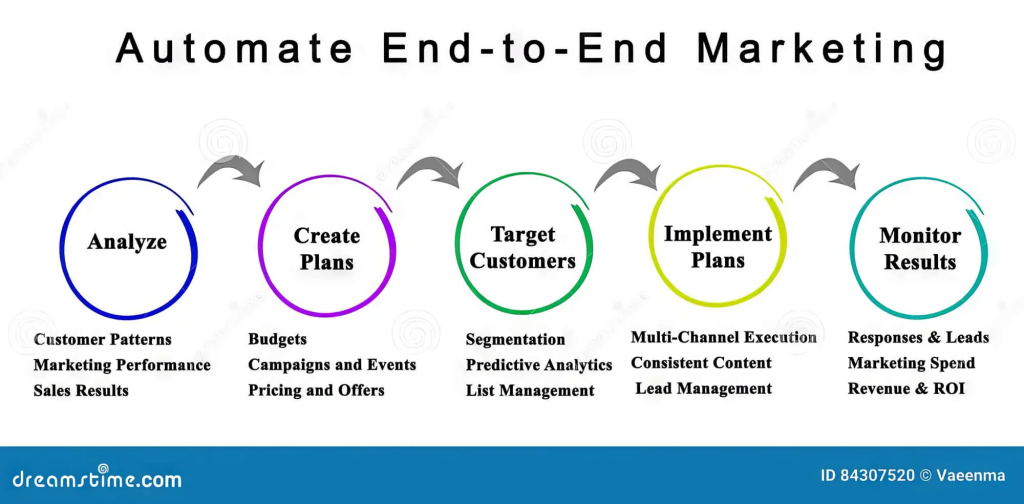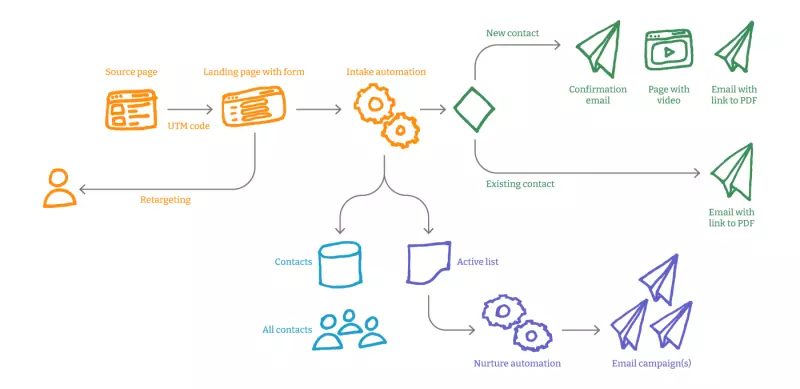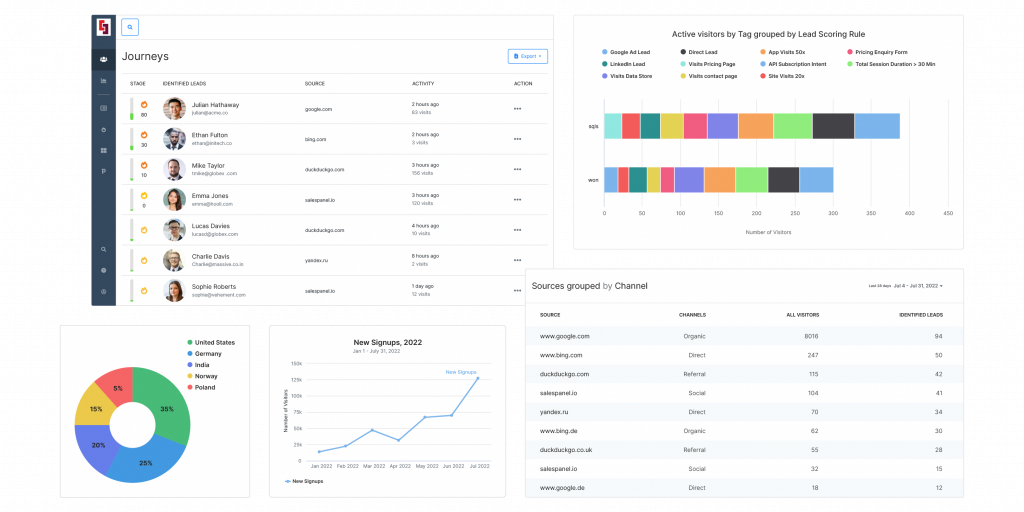Guide to End-to-End Marketing and Implementation
Reading Time: 8 minutes
Do you know which departments CEOs hate the most?
It’s marketing!
Several surveys have pointed to the fact that CEOs have a love-hate relationship with marketing and marketing leaders like CMOs are executives CEOs are always at odds with.
Why? The answer is simple. Marketing is a cost-center and marketing teams have a hard time linking their marketing efforts to revenue.
This is where end-to-end (e2e) marketing (also called full-funnel marketing) comes into play.
End-to-end (e2e) marketing, or full-funnel marketing, offers a solution by enabling marketing to fully oversee and track the customer journey from start to finish. This method helps to clarify how marketing actions contribute to sales and revenue.
This blog post will explain e2e marketing, its operation, the importance of tracking the entire customer journey, and how to apply a full-funnel marketing approach. We aim to show how e2e marketing can transform marketing from a questioned cost center into a clear contributor to a company’s revenue and showcasing the tangible value of marketing investments.

What is End-to-End Marketing?
End-to-end marketing, also known as full-funnel marketing, is a comprehensive approach that focuses on monitoring and optimizing every stage of the customer’s journey, from the moment they become aware of your brand to the point of purchase and beyond. Unlike traditional methods that often rely on aggregate data to assess performance, such as the statistical analysis provided by tools like Google Analytics, end-to-end marketing zeroes in on the nuances of individual customer interactions.
This strategy is rooted in the belief that understanding each touchpoint in a customer’s journey is crucial for crafting more personalized and effective marketing campaigns. By analyzing the details of how individual customers interact with your brand—whether through social media, email campaigns, website visits, or direct contact—marketers can gain insights into customer preferences, behaviors, and potential roadblocks in the conversion process.
What Challenges Do You Solve with End-to-End Marketing?
End-to-end marketing addresses several key challenges that businesses face in their quest to align marketing efforts with revenue generation and optimize the customer journey. Let’s have a look:
1. Challenges With Connecting Marketing Campaigns to Revenue
A major hurdle for marketing teams is demonstrating how their campaigns contribute directly to the company’s revenue. Traditional marketing approaches often struggle to connect specific initiatives with financial outcomes. End-to-end marketing overcomes this by tracking the customer journey in its entirety, allowing for a clearer understanding of how each marketing action influences a customer’s decision to purchase. This approach provides tangible evidence of marketing’s impact on revenue, facilitating more informed decisions on where to allocate resources for maximum return on investment.
2. Overcoming Weak Tracking and Unclear Data
Without a strong framework for tracking the customer journey, it becomes challenging to gauge how individuals interact with various marketing campaigns and touchpoints. This issue is particularly pronounced in B2B contexts, where the purchasing process is typically longer and more complex than in B2C. End-to-end marketing strengthens tracking mechanisms by offering detailed insights into every customer interaction. This enables marketers to identify which strategies are effective and how each touchpoint contributes to moving a prospect through the funnel toward conversion.
3. Navigating Long Customer Journeys and Funnel Bottlenecks
The extended nature of customer journeys, especially in the B2B sector, can lead to bottlenecks where prospects stall or drop out of the funnel. These bottlenecks may occur due to a variety of reasons, such as lack of targeted messaging, poor lead nurturing practices, or insufficient engagement at critical decision-making stages. End-to-end marketing provides a granular view of the customer journey, highlighting areas where prospects disengage and allowing marketers to implement targeted interventions. By addressing these bottlenecks directly, businesses can smooth the path to purchase, enhancing the overall efficiency of the funnel.

Benefits of End-to-End Marketing
Implementing end-to-end marketing brings a suite of advantages that can significantly enhance a company’s marketing strategy and its alignment with broader business objectives. Here are some of the benefits:
1. Granular Control Over the Marketing Funnel
End-to-end marketing grants marketers unprecedented control over every phase of the customer journey. This comprehensive oversight means that businesses can effectively guide prospects from initial awareness through to conversion and beyond. With the ability to engage customers at each stage of the funnel, companies can deploy targeted interventions designed to nudge prospects closer to making a purchase, ensuring that no potential customer falls through the cracks.
2. Enhanced Understanding of Buyer Intent
By analyzing data from various marketing touchpoints and customer interactions, businesses can gain deep insights into buyer intent. This information is crucial for refining and personalizing marketing campaigns to match the specific needs and interests of the audience. Understanding what drives customers at different stages of their journey enables marketers to craft messages and offers that resonate, significantly increasing the likelihood of conversion.
3. Precise Identification of High-Performance Campaigns
One of the standout benefits of end-to-end marketing is the ability to pinpoint exactly which campaigns and touchpoints are driving customer acquisition and contributing to revenue. This level of specificity allows businesses to allocate their marketing budget more effectively, focusing resources on the strategies that deliver the best return on investment. Identifying these high-impact activities also provides valuable insights that can guide the strategic direction of future marketing efforts.
4. Streamlined Multi-Step Marketing Strategies
The complex nature of modern marketing strategies, often involving multiple steps and channels, requires a robust framework for tracking and analysis. End-to-end marketing meets this need by offering a system that not only supports the execution of intricate marketing strategies but also tracks their outcomes with precision. This capability enables marketers to understand the effectiveness of their efforts across the entire funnel and adjust their tactics in real-time to optimize performance.
5. Improved Customer Retention and Reduced Churn
Finally, the insights garnered from a comprehensive view of the customer journey can be leveraged to enhance customer retention. By identifying points of friction and disengagement, businesses can implement targeted strategies to keep customers satisfied and engaged. This proactive approach to managing the customer experience not only reduces churn but also fosters loyalty, encouraging repeat business and positive word-of-mouth referrals.
The benefits of implementing end-to-end marketing extend far beyond mere operational improvements. This strategy enables a more nuanced understanding of the customer journey, facilitates the optimization of marketing efforts, and enhances the ability to drive meaningful engagement.

Implementing End-to-End Marketing
Now that we understand the benefits derived from this full-funnel marketing approach, here’s a step-by-step guide to effectively implementing end-to-end marketing:
1. Developing Buyer Personas
The first step in an end-to-end marketing strategy is to construct detailed buyer personas. These personas represent your ideal customer profiles, distilled through research and data analysis, encapsulating their needs, preferences, behaviors, and pain points. By targeting these well-defined personas in your campaigns, you can ensure that your marketing efforts are highly relevant and engaging to the people most likely to convert into customers.
2. Establishing a Customer Journey Tracking Framework
With your target personas in hand, the next step is to map out and establish a framework for tracking the customer journey. This involves identifying all possible touchpoints where potential customers may interact with your brand, from initial awareness through consideration, decision, and post-purchase phases. Implementing technology solutions that can capture and analyze interactions at each stage is crucial for gaining insights into customer behavior and preferences.
3. Crafting Multi-Touchpoint Strategies
Armed with a deep understanding of your buyer personas and a robust tracking framework, you can then create multi-touchpoint marketing strategies. These strategies should encompass a variety of channels such as social media, search engine ads, email campaigns, content marketing, and more. The goal is to engage your target audience across different platforms and mediums, offering consistent, personalized messaging that resonates with their specific interests and needs.
4. Analyzing Touchpoints and Customer Interactions from Different Channels
The core of end-to-end marketing lies in the continuous analysis of touchpoints and tracking of prospects. This step involves closely monitoring how customers interact with your brand across all channels, gathering data on their preferences, and identifying patterns in their behavior. By understanding the paths your customers take, you can identify opportunities for optimization and personalization.
5. Leveraging Data for Analytics and Marketing Enablement
The culmination of your end-to-end marketing efforts is the use of gathered data for analytics and marketing enablement. This involves analyzing the data collected from various touchpoints to gain actionable insights into customer behavior and campaign performance. These insights can then be used to refine your marketing strategies, personalize your messaging, and make informed decisions about where to allocate resources for the best return on investment.
Implementing end-to-end marketing is an iterative process that requires ongoing adjustment and optimization. By continually refining your strategies based on real-time data and insights, you can enhance the effectiveness of your marketing efforts, deliver a superior customer experience, and drive sustainable business growth.
Using Salespanel for End-to-End Marketing
Before we close this article, we want to tell you how Salespanel can help you with attributing campaigns and tracking customer journeys. Here’s how it helps:
1. Comprehensive Tracking Across the Customer Journey
Salespanel excels in providing end-to-end tracking of every B2B customer’s journey. This means from the initial interaction with your brand, through various touchpoints and marketing campaigns, to the point of conversion and beyond, Salespanel captures and organizes all customer interactions. This detailed tracking allows businesses to understand the full context of each customer’s path, enabling more informed marketing and sales strategies.
2. Conversion Tracking and Attribution
Understanding which marketing campaigns and touchpoints lead to conversions is crucial for optimizing marketing spend and strategy. Salespanel facilitates this by tracking conversions across different campaigns, allowing you to see which efforts are producing results. This enables you to attribute success to specific initiatives, providing clear insights into which elements of your marketing strategy are driving customer acquisition.
3. Visibility into Lead Progression
With Salespanel, you gain insight into the progression of visitors turning into leads and leads into customers. This capability allows for the attribution of data to individual campaigns and marketing touchpoints, offering a granular view of what’s working in your marketing funnel. Such insights are invaluable for refining your approach to nurture leads more effectively toward conversion.
4. Targeted Content and Actions
Leveraging buyer intent data, Salespanel helps in serving targeted content and taking strategic actions tailored to the needs and behaviors of potential customers. By understanding where a prospect is in the buying journey and what their specific interests are, you can customize your messaging and offers to increase engagement and conversion likelihood.
5. Simplified Analysis for Strategic Insights
Salespanel provides a 360-degree view of your end-to-end marketing efforts, simplifying the analytical process. This comprehensive overview eliminates the need for complex data analysis, making it easier for businesses to assess the effectiveness of their marketing strategies. With Salespanel, you can quickly identify areas of success and opportunities for improvement, streamlining your efforts toward achieving better outcomes.
Incorporating Salespanel into your end-to-end marketing implementation not only enhances the precision and effectiveness of your tracking and analysis but also provides actionable insights for optimizing your marketing strategies. This level of detail and clarity supports more targeted, efficient, and successful marketing efforts, driving better engagement, conversions, and customer satisfaction.

Final Thoughts
End-to-end marketing emerges as a powerful solution to the longstanding challenges marketing departments face in proving their impact on revenue and navigating complex customer journeys. By providing a comprehensive overview of the customer’s path from awareness to conversion, end-to-end marketing enables businesses to make informed, data-driven decisions that enhance marketing effectiveness. Implementing this approach, especially with the aid of tools like Salespanel, allows for detailed tracking, personalized strategies, and improved customer retention, transforming marketing from a questioned cost center into a vital contributor to a company’s financial success. Embracing end-to-end marketing is not just about improving marketing outcomes; it’s about aligning marketing efforts more closely with overall business objectives for sustainable growth and customer satisfaction.
Sell more, understand your customers’ journey for free!
Sales and Marketing teams spend millions of dollars to bring visitors to your website. But do you track your customer’s journey? Do you know who buys and why?
Around 8% of your website traffic will sign up on your lead forms. What happens to the other 92% of your traffic? Can you identify your visiting accounts? Can you engage and retarget your qualified visitors even if they are not identified?
